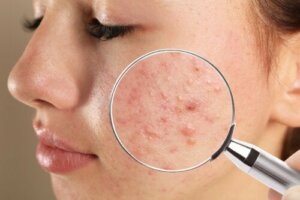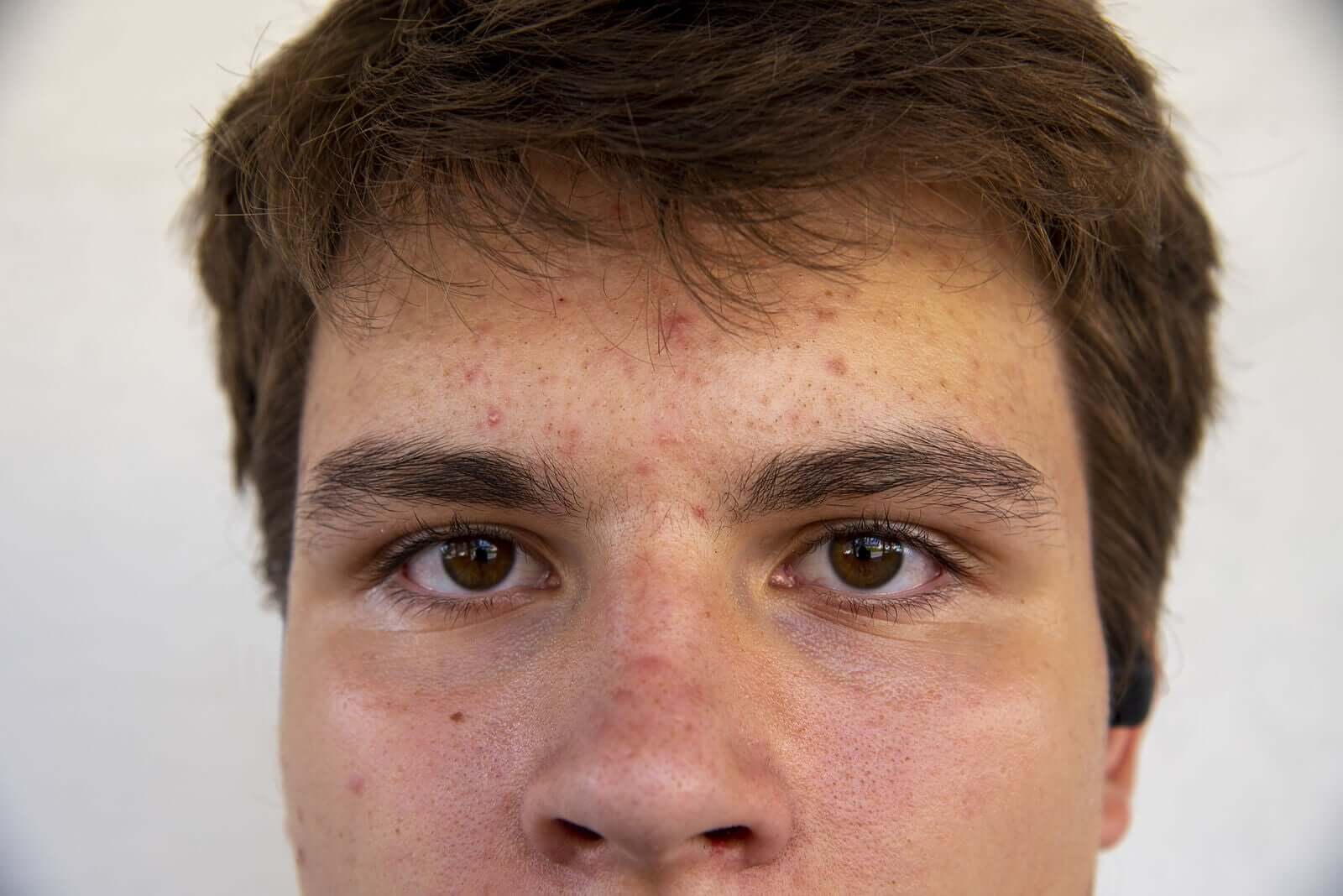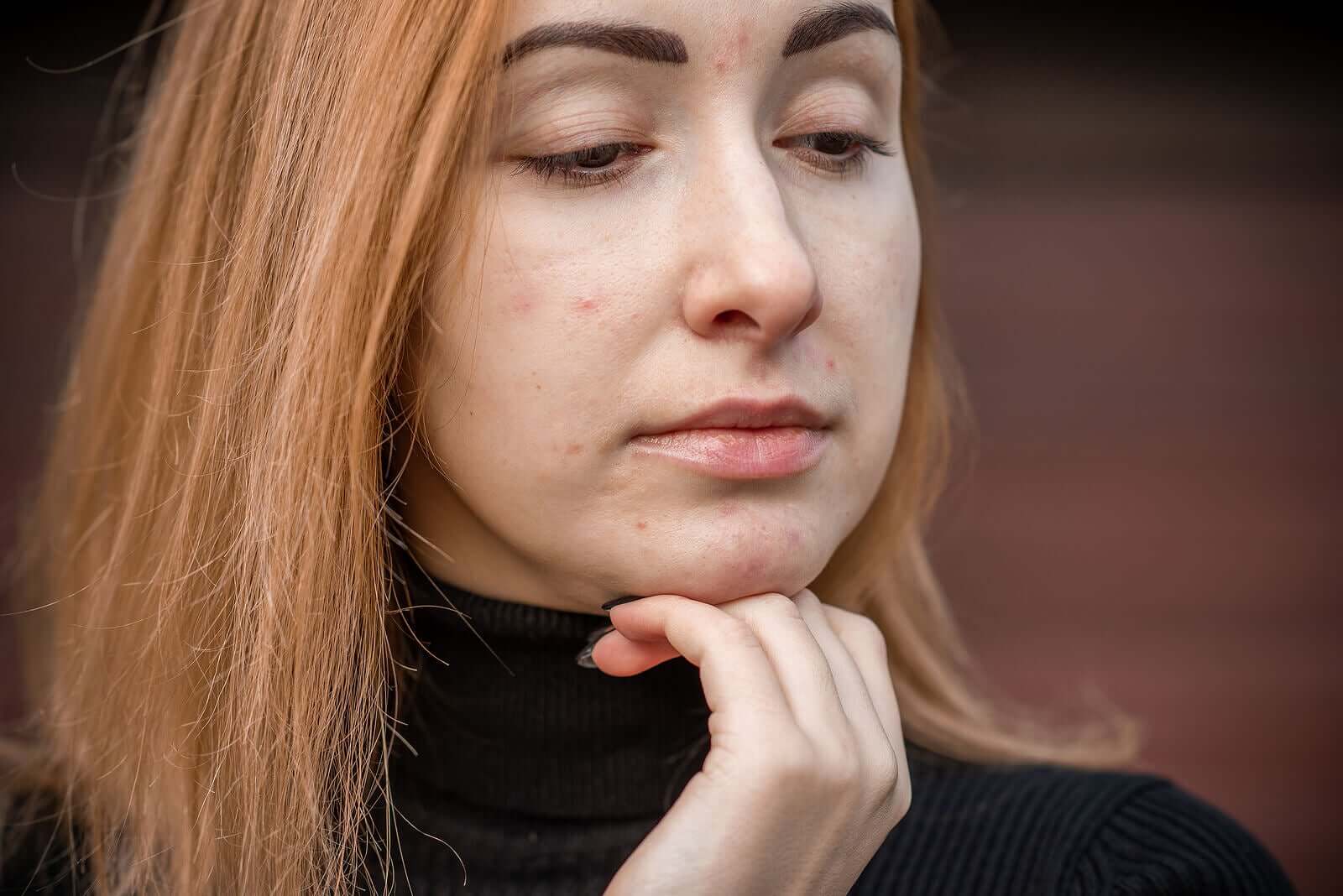Teenage Acne: Types and Causes


Written and verified by the dermatologist Maria del Carmen Hernandez
Teenage acne is one of the skin manifestations that most concern teenagers. It usually affects their self-esteem and social life. Many causes, like hormonal alterations or bad hygiene are responsible for its appearance. Next, you’ll find more information about it.
What are the causes of teenage acne?
Teenage acne is an inflammatory disorder of the pilosebaceous unit, which runs a chronic course and it’s self-limiting. In most cases, it’s triggered by Cutibacterium acnes in adolescence, under the influence of normal circulating dehydroepiandrosterone (DHEA).
It’s a very common skin disorder, which can appear with inflammatory and noninflammatory lesions. It’s normally present on the face, but it can also occur on the upper arms, torso and back.

Causes of teenage acne:
- Use of medication, like lithium, steroids and anticonvulsants.
- Excessive exposure to sunlight.
- Use of occlusive wear.
- Endocrine disorders, such as polycystic ovary syndrome and even pregnancy.
- Genetic factors affect the percentage of fatty acids in sebum. Genetics accounts for an estimated 50-90% of cases.
Acne and food
Acne and food have a quite controversial relationship. Most likely, the comedogenic effects of milk and dairy products come from the cow’s production of hormones during pregnancy.
According to studies from the journal of the American Academy of Dermatology, the component of the milk that affects the pilosebaceous unit is a growth factor, similar to insulin 1 (IGF-1). The level of this growth factor in the blood varies according to the seriousness of the acne present.
Similar to insulin 1, the levels of this growth factor increase during puberty, due to the growth hormone. And, this relates directly to the evolution of acne.
Dark chocolate contains more antioxidant than milk chocolate. Thus, dark chocolate may have lesser comedogenic effects than milk chocolate.
Therefore, it’s important to change eating habits to prevent the appearance of acne. This means avoiding chocolate, spicy food, junk food and cola drinks. As a result, a high protein and low glycemic diet may reduce acne lesions.
Types of teenage acne
Acne usually appears on the center of the face, the back, the lower trunk and the deltoid area. In most cases, it manifests as polyform lesions that start as comedones.
Grade 1: superficial, noninflammatory
This is the type of acne that appears in the beginning, and it’s minor. Therefore, it’s superficial and it doesn’t present a predominant inflammatory pattern. It’s characterized by two types of comedones: open and closed (also known as blackheads or pimples).
In addition, you may find papules in the affected areas, which don’t show a high degree of inflammation. Finally, there’s no other lesion present in this type of acne.
Grade 2: inflammatory, superficial
This type of acne is more serious, but lesions are still superficial. There’s inflammation in the affected areas, and the following lesions are present:
- Open and closed comedones.
- Inflammation.
- Papules and pustules (low quantity)
- No nodules.
- No scars.

Grade 3: highly inflammatory
In this type of acne, you can observe more inflammation and the appearance of other unpleasant lesions. So, inflammation gets more severe, in comparison to other types of acne. And, more papules and pustules appear.
What’s more, a small amount of skin nodules are present in this grade.
Grade 4: severe and nodular cystic
This is the most serious type of acne. Furthermore, it’s nodular cystic because new lesions appear, which compromise more skin area. Here’s a list of the lesions that may appear in this grade:
- Severe inflammation.
- Open and closed comedones.
- Papules and pustules.
- Nodules (great number).
- Different types of scars.
Recommendations to take into account
You can’t avoid having acne, but you can control it. So, wash your face regularly, using a pH balancing wash (available as benzoyl peroxide and salicylic acid).
Since they play an important role in the pathogenesis, try to avoid dairy products and high glycemic food.
Stress control, early detection and treatment of related causes, such as polycystic ovary syndrome, help control acne and avoid lesions.
Teenage acne isn’t just a skin pathology
Acne may not put your life in danger, but it has psychosocial effects. According to the American Academy of Dermatology, people with acne or acne scars often develop anxiety and depression problems.
If you follow a proper treatment, acne’s prognosis might be good. Thus, treatment will be different depending on the type of acne each person has. If you have a minor case of acne, like blackheads or whiteheads, treatment is usually easy. However, if you suffer from inflammatory or cystic acne, treatment might be more challenging.
Teenage acne is one of the skin manifestations that most concern teenagers. It usually affects their self-esteem and social life. Many causes, like hormonal alterations or bad hygiene are responsible for its appearance. Next, you’ll find more information about it.
What are the causes of teenage acne?
Teenage acne is an inflammatory disorder of the pilosebaceous unit, which runs a chronic course and it’s self-limiting. In most cases, it’s triggered by Cutibacterium acnes in adolescence, under the influence of normal circulating dehydroepiandrosterone (DHEA).
It’s a very common skin disorder, which can appear with inflammatory and noninflammatory lesions. It’s normally present on the face, but it can also occur on the upper arms, torso and back.

Causes of teenage acne:
- Use of medication, like lithium, steroids and anticonvulsants.
- Excessive exposure to sunlight.
- Use of occlusive wear.
- Endocrine disorders, such as polycystic ovary syndrome and even pregnancy.
- Genetic factors affect the percentage of fatty acids in sebum. Genetics accounts for an estimated 50-90% of cases.
Acne and food
Acne and food have a quite controversial relationship. Most likely, the comedogenic effects of milk and dairy products come from the cow’s production of hormones during pregnancy.
According to studies from the journal of the American Academy of Dermatology, the component of the milk that affects the pilosebaceous unit is a growth factor, similar to insulin 1 (IGF-1). The level of this growth factor in the blood varies according to the seriousness of the acne present.
Similar to insulin 1, the levels of this growth factor increase during puberty, due to the growth hormone. And, this relates directly to the evolution of acne.
Dark chocolate contains more antioxidant than milk chocolate. Thus, dark chocolate may have lesser comedogenic effects than milk chocolate.
Therefore, it’s important to change eating habits to prevent the appearance of acne. This means avoiding chocolate, spicy food, junk food and cola drinks. As a result, a high protein and low glycemic diet may reduce acne lesions.
Types of teenage acne
Acne usually appears on the center of the face, the back, the lower trunk and the deltoid area. In most cases, it manifests as polyform lesions that start as comedones.
Grade 1: superficial, noninflammatory
This is the type of acne that appears in the beginning, and it’s minor. Therefore, it’s superficial and it doesn’t present a predominant inflammatory pattern. It’s characterized by two types of comedones: open and closed (also known as blackheads or pimples).
In addition, you may find papules in the affected areas, which don’t show a high degree of inflammation. Finally, there’s no other lesion present in this type of acne.
Grade 2: inflammatory, superficial
This type of acne is more serious, but lesions are still superficial. There’s inflammation in the affected areas, and the following lesions are present:
- Open and closed comedones.
- Inflammation.
- Papules and pustules (low quantity)
- No nodules.
- No scars.

Grade 3: highly inflammatory
In this type of acne, you can observe more inflammation and the appearance of other unpleasant lesions. So, inflammation gets more severe, in comparison to other types of acne. And, more papules and pustules appear.
What’s more, a small amount of skin nodules are present in this grade.
Grade 4: severe and nodular cystic
This is the most serious type of acne. Furthermore, it’s nodular cystic because new lesions appear, which compromise more skin area. Here’s a list of the lesions that may appear in this grade:
- Severe inflammation.
- Open and closed comedones.
- Papules and pustules.
- Nodules (great number).
- Different types of scars.
Recommendations to take into account
You can’t avoid having acne, but you can control it. So, wash your face regularly, using a pH balancing wash (available as benzoyl peroxide and salicylic acid).
Since they play an important role in the pathogenesis, try to avoid dairy products and high glycemic food.
Stress control, early detection and treatment of related causes, such as polycystic ovary syndrome, help control acne and avoid lesions.
Teenage acne isn’t just a skin pathology
Acne may not put your life in danger, but it has psychosocial effects. According to the American Academy of Dermatology, people with acne or acne scars often develop anxiety and depression problems.
If you follow a proper treatment, acne’s prognosis might be good. Thus, treatment will be different depending on the type of acne each person has. If you have a minor case of acne, like blackheads or whiteheads, treatment is usually easy. However, if you suffer from inflammatory or cystic acne, treatment might be more challenging.
All cited sources were thoroughly reviewed by our team to ensure their quality, reliability, currency, and validity. The bibliography of this article was considered reliable and of academic or scientific accuracy.
- Arora, M. K., Yadav, A., & Saini, V. (2011). Role of hormones in acne vulgaris. Clinical biochemistry, 44(13), 1035-1040. https://pubmed.ncbi.nlm.nih.gov/21763298/
- Bataille, V., Snieder, H., MacGregor, A. J., Sasieni, P., & Spector, T. D. (2002). The influence of genetics and environmental factors in the pathogenesis of acne: a twin study of acne in women. Journal of Investigative Dermatology, 119(6), 1317-1322. https://pubmed.ncbi.nlm.nih.gov/12485434/
- Danby, F. W. (2005). Acne and milk, the diet myth, and beyond. Journal of the American Academy of Dermatology, 52(2), 360-362. https://pubmed.ncbi.nlm.nih.gov/15692488/
- Block, S. G., Valins, W. E., Caperton, C. V., Viera, M. H., Amini, S., & Berman, B. (2011). Exacerbation of facial acne vulgaris after consuming pure chocolate. Journal of the American academy of dermatology, 65(4), e114-e115. https://pubmed.ncbi.nlm.nih.gov/21920227/
- AAD. (n.d.). Acne can affect more than your skin. American Academy of Dermatology. https://www.aad.org/public/diseases/acne/acne-emotional-effects
This text is provided for informational purposes only and does not replace consultation with a professional. If in doubt, consult your specialist.








